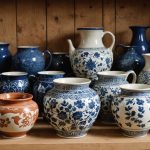Unveiling the Art of Traditional UK Pottery: Where to Immerse Yourself in Craftsmanship
Discovering the Rich Heritage of UK Pottery
The United Kingdom is renowned for its rich and diverse heritage in pottery, a craft that has been honed over centuries. From the iconic pottery towns of Stoke-on-Trent to the quaint villages of the south west, the UK offers a plethora of opportunities to immerse yourself in the art and craftsmanship of traditional pottery.
Stoke-on-Trent: The Heart of UK Pottery
Stoke-on-Trent, often referred to as the “Potteries,” is the epicenter of UK pottery. This region has been the hub of ceramic production since the 17th century, with famous names like Wedgwood, Royal Doulton, and Spode contributing to its illustrious history. A visit to the World of Wedgwood museum is a must, where you can delve into the history of ceramics and even participate in a pottery painting workshop. As Emma Bridgewater, a contemporary pottery designer, notes, “The heritage of Stoke-on-Trent is unparalleled; it’s where the art of pottery comes alive.”
This might interest you : Discover Interactive Literary Tours of Iconic UK Locations: Your Guide to Famous Stories Come to Life!
Exploring Local Workshops and Classes
To truly experience the craftsmanship of UK pottery, attending a workshop or class is essential. Here are some notable places where you can get hands-on with pottery:
The Emma Bridgewater Factory
Located in Stoke-on-Trent, the Emma Bridgewater factory offers a unique experience where guests can paint their own pottery. This interactive workshop allows you to immerse yourself in the process, from selecting your piece to applying the final glaze. As Emma Bridgewater explains, “Our workshops are designed to make pottery accessible to everyone. It’s a fun and creative way to spend time, and you get to take home your own handmade piece.”
Topic to read : Discover the Charm of London”s Historic East End: Join a Guided Walking Tour of Its Iconic Markets!
The Leach Pottery in St Ives
In the picturesque town of St Ives, Cornwall, the Leach Pottery is a legendary studio founded by Bernard Leach, a pioneer of studio pottery. Here, you can take classes and workshops that follow the traditional methods of Leach and his contemporaries. The studio runs regularly scheduled classes, from beginner pottery painting to advanced glazing techniques.
Unique Pottery Experiences
Beyond the traditional workshops, there are several unique experiences that allow you to delve deeper into the world of UK pottery.
Pottery Painting Workshops in London
In the heart of London, you can find various pottery painting workshops that offer a creative escape from the city’s hustle and bustle. These workshops often feature a team-building aspect, making them an excellent choice for corporate events or social gatherings. A painting class teacher at one such workshop notes, “Our pottery painting sessions are not just about creating art; they’re about bonding and having a good time.”
The Pottery Heritage of the South West
The south west of England, particularly the Cotswolds, is home to a number of historical pottery sites. For instance, the town of Chipping Campden boasts the Almshouses, built in 1612, which feature local limestone known as Cotswold stone. While not directly related to pottery, these historical sites provide a glimpse into the traditional craftsmanship that pervades the region.
A Detailed Look at Traditional Pottery Techniques
Traditional UK pottery is characterized by several distinct techniques that have been passed down through generations.
Hand-Building and Throwing
One of the oldest methods is hand-building, where pottery is formed using coils or spirals of clay. This technique dates back to prehistoric times and is still practiced today. Throwing on a potter’s wheel, which originated around 4000 BC, is another fundamental method. As Lucie Rie, a renowned potter, once said, “The wheel is an extension of the hand; it allows for precision and fluidity in creating forms.”
Glazing and Firing
Glazing is a critical step in pottery, adding color and protection to the ceramic piece. The type of glaze and firing technique can significantly alter the final appearance. For example, the “terre sigillée” method involves applying a thin layer of red clay and water to facilitate the glazing process, resulting in either a red-orange or black finish depending on the firing atmosphere[3].
Table: Comparing Notable UK Pottery Brands
| Brand | Founded | Notable Products | Techniques | Heritage |
|---|---|---|---|---|
| Wedgwood | 1759 | Fine Bone China | High-temperature firing, intricate designs | Founded by Josiah Wedgwood, known for Jasperware |
| Royal Doulton | 1815 | Figurines, Tableware | Hand-painting, glazing | Known for its Lambeth studio and character jugs |
| Spode | 1767 | Blue Italian, Woodland | Transfer printing, underglaze blue | Introduced the first fine bone china |
| Emma Bridgewater | 1985 | Decorative Tableware | Hand-painting, sgraffito | Known for its colorful, whimsical designs |
| Leach Pottery | 1920 | Studio Pottery | Hand-building, throwing, high-temperature firing | Founded by Bernard Leach, a pioneer of studio pottery |
Practical Insights and Actionable Advice
If you’re interested in exploring the world of UK pottery, here are some practical tips and advice:
Choosing the Right Workshop
- Research Local Workshops: Look for workshops that align with your interests and skill level. Some workshops may focus more on traditional techniques, while others might offer more modern and experimental approaches.
- Check Reviews and Testimonials: See what past participants have to say about their experiences. This can give you a better idea of what to expect.
Investing in Quality Materials
- Select Good Quality Clay: The type of clay you use can significantly affect the outcome of your pottery. Look for clay that is suitable for your project, whether it’s earthenware, stoneware, or porcelain.
- Use Proper Tools: Investing in the right tools, such as a potter’s wheel or hand-building tools, can make the process much easier and more enjoyable.
Joining a Pottery Community
- Local Pottery Groups: Joining local pottery groups or clubs can be a great way to learn from others, share techniques, and stay motivated.
- Online Forums: Participate in online forums or social media groups dedicated to pottery. These communities often share tips, tutorials, and inspiration.
The art of traditional UK pottery is a rich and vibrant tapestry of history, craftsmanship, and creativity. Whether you’re a seasoned potter or just starting out, there are countless ways to immerse yourself in this world. From the historic factories of Stoke-on-Trent to the quaint workshops of the south west, each experience offers a unique glimpse into the heritage and techniques that define UK pottery.
As you embark on this journey, remember that pottery is not just about creating functional items; it’s about the process, the people, and the stories behind each piece. So, take the time to discover, to learn, and to immerse yourself in the craftsmanship that makes UK pottery so special.
Additional Resources
-
Workshop Followers Choice:
-
Emma Bridgewater Factory: Offers regular workshops and classes.
-
Leach Pottery: Provides a range of classes from beginner to advanced levels.
-
Local Pottery Workshops in London: Various studios offer pottery painting and glazing workshops.
-
Ceramic Painting Tips:
-
Start with simple designs and gradually move to more complex patterns.
-
Use high-quality glazes and follow the manufacturer’s instructions.
-
Practice makes perfect; don’t be discouraged by initial mistakes.
-
Team Building Activities:
-
Organize a group pottery painting session for a fun and interactive team-building activity.
-
Encourage collaboration and creativity within the group.
By following these tips and immersing yourself in the world of UK pottery, you’ll not only gain a new skill but also appreciate the time, effort, and craftsmanship that goes into creating these beautiful pieces.











